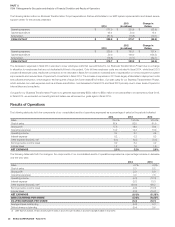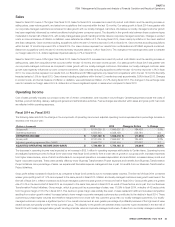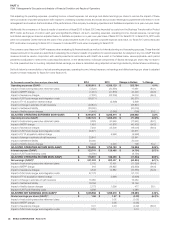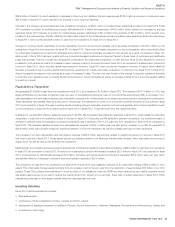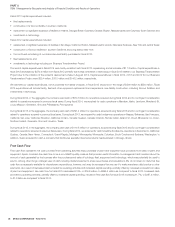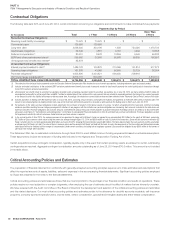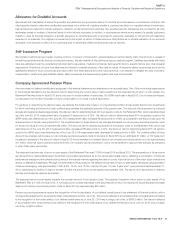Sysco 2014 Annual Report Download - page 43
Download and view the complete annual report
Please find page 43 of the 2014 Sysco annual report below. You can navigate through the pages in the report by either clicking on the pages listed below, or by using the keyword search tool below to find specific information within the annual report.SYSCO CORPORATION-Form10-K 31
PARTII
ITEM7Management’s Discussion and Analysis ofFinancial Condition and Results of Operations
Broadline Segment
The Broadline reportable segment is an aggregation of the company’s U.S., Canadian, Caribbean and European Broadline segments. Broadline operating
companies distribute a full line of food products and a wide variety of non-food products to both traditional and chain restaurant customers, hospitals,
schools, hotels, industrial caterers and other venues where foodservice products are served. These companies also provide custom-cut meat operations.
Broadline operations have signi cantly higher operating margins than the rest of Sysco’s operations. In scal 2014, the Broadline operating results represented
approximately 81.0% of Sysco’s overall sales and 94.9% of the aggregate operating income of Sysco’s segments, which excludes corporate expenses.
There are several factors which contribute to these higher operating results as compared to the SYGMA and Other operating segments. We have invested
substantial amounts in assets, operating methods, technology and management expertise in this segment. The breadth of its sales force, geographic reach
of its distribution area and its purchasing power allow us to bene t from this segment’s earnings.
Sales
Sales for scal 2014 were 4.4% higher than scal 2013. Sales for scal 2014 increased as a result of sales from acquisitions that occurred within the last
12 months, case volume growth and product cost in ation and the resulting increase in selling prices. Our sales growth in scal 2014 was greater with our
corporate-managed customers as compared to sales growth with our locally-managed customers. We believe our locally-managed customer growth has
been negatively in uenced market conditions including lower consumer spend. The disparity in the growth rate between these customer types moderated
in the last half of scal 2014 with locally-managed sales growth trending at similar rates as corporate-managed customers. Sales from acquisitions within
the last 12 months favorably impacted sales by 1.7% in scal 2014. Changes in product costs, an internal measure of in ation or de ation, were estimated
as in ation of 2.0% during scal 2014, driven mainly by in ation in the meat, seafood and dairy categories. The exchange rates used to translate our foreign
sales into U.S. dollars negatively impacted sales by 0.8% in scal 2014.
Sales were 5.0% greater in scal 2013 than scal 2012. Sales for scal 2013 increased as a result of product cost in ation and the resulting increase in
selling prices, sales from acquisitions that occurred within the last 12 months and improving case volumes. Our sales growth in scal 2013 has been greater
with our corporate-managed customers as compared to sales growth with our locally-managed customers. We believe our locally-managed customer sales
growth has been negatively in uenced by lower consumer sentiment. Sales from acquisitions within the last 12 months contributed 1.6% to the overall sales
comparison for scal 2013. Changes in product costs, an internal measure of in ation or de ation, were estimated as in ation of 2.3% in scal 2013. The
changes in the exchange rates used to translate our foreign sales into U.S. dollars did not have a signi cant impact on sales when compared to scal 2012.
Operating Income
Fiscal 2014 vs. Fiscal 2013
Operating income increased by 3.1% in scal 2014 over scal 2013. Fiscal 2014 included $1.5 million in charges related to withdrawals from multiemployer
pension plans, as compared to $41.9 million in charges in scal 2013. We also experienced growth in our gross pro ts, increased expenses from higher
case volumes, some of which is attributable to our acquired operations, increased depreciation and amortization and increased delivery costs. These were
partially offset by bene ts from Business Transformation Project initiatives included lower sales organization costs and retirement-related expenses. As a
percentage of sales, we experienced favorable expense management partially from bene ts from our Business Transformation Project initiatives.
Gross pro t dollars increased in scal 2014 primarily due to increased sales; however, gross pro t dollars increased at a lower rate than sales. Gross pro ts
grew at a greater rate in the second half of scal 2014 as compared to the same time period in scal 2013 as result of increased in ation, higher locally-
managed customer case growth and in part from our Business Transformation Project initiatives. This decline in gross margin was partially the result of
weak restaurant traf c and increased competition resulting from a slow-growth market. Increased sales to lower margin corporate-managed customers also
contributed to the decline in scal 2014. These customers purchase higher volumes and therefore margins tend to be lower with this customer group than
our locally-managed customers. Our locally-managed customers comprise a signi cant portion of our overall volumes and an even greater percentage of
pro tability because of the high level of value added services we typically provide to this customer group. The disparity in the growth rate between these
customer types moderated in the last half of scal 2014 with locally-managed sales growth trending at similar rates as corporate-managed customers.
If sales from our locally-managed customers do not grow at the same rate as sales from these corporate-managed customers, our gross margins may
continue to decline. Our in ation rates were relatively stable over the rst three quarters of scal 2014; however, it increased in the fourth quarter, all quarters
being compared to the past year. Fourth quarter scal 2014 in ation was seen primarily in the meat, seafood and dairy categories which represent more
than one-third of our annual sales. While we cannot predict whether in ation will continue at current levels, periods of high in ation, either overall or in certain
product categories, can have a negative impact on us and our customers, as high food costs can be dif cult to pass on to our customers and in ation
can reduce consumer spending in the food-away-from-home market, and may negatively impact our sales, gross pro t, operating income and earnings.
Operating expenses for the Broadline segment increased in scal 2014 as compared to scal 2013. Fiscal 2014 included $1.5 million in charges related
to withdrawals from multiemployer pension plans, as compared to $41.9 million in charges in scal 2013. The increase in expenses for scal 2014 as
compared to scal 2013 was driven largely by expenses from acquired operations, expenses attributable to volume growth and increased depreciation
and amortization expense. Pay-related expenses increased primarily from added costs from companies acquired in the last 12 months as well as increased
delivery compensation, partially attributable to case growth. Depreciation and amortization increased primarily from assets that were not placed in service



